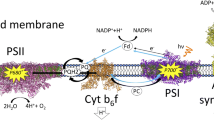Abstract
Antifreeze proteins (AFPs) are widely employed by various organisms as part of their overwintering survival strategy. AFPs have the unique ability to suppress the freezing point of aqueous solution and inhibit ice recrystallization through binding to the ice seed crystals and restricting their growth. The solution structure of CfAFP-501 from spruce budworm has been determined by NMR spectroscopy. Our result demonstrates that CfAFP-501 retains its rigid and highly regular structure in solution. Overall, the solution structure is similar to the crystal structure except the N- and C-terminal regions. NMR spin-relaxation experiments further indicate the overall rigidity of the protein and identify a collection of residues with greater flexibilities. Furthermore, Pro91 shows a cis conformation in solution instead of the trans conformation determined in the crystal structure.
Similar content being viewed by others
References
D.A. Case et al. (2002) AMBER 7 University of California San Francisco, CA
G. Cornilescu et al. (1999) J. Biomol. NMR 13 289–302 Occurrence Handle10.1023/A:1008392405740 Occurrence Handle10212987
F. Delaglio et al. (1995) J. Biomol. NMR 6 277–293 Occurrence Handle10.1007/BF00197809 Occurrence Handle8520220
D. Doucet et al. (2000) Eur. J. Biochem. 267 6082–6088 Occurrence Handle10.1046/j.1432-1327.2000.01694.x Occurrence Handle10998070
N.A. Farrow et al. (1994) Biochemistry 33 5984–6003 Occurrence Handle10.1021/bi00185a040 Occurrence Handle7514039
G.L. Fletcher et al. (2001) Annu. Rev. Physiol. 63 359–390 Occurrence Handle10.1146/annurev.physiol.63.1.359 Occurrence Handle11181960
S.Y. Gauthier et al. (1998) Eur. J. Biochem. 258 445–453 Occurrence Handle10.1046/j.1432-1327.1998.2580445.x Occurrence Handle9874210
S.P. Graether et al. (2000) Nature 406 325–328 Occurrence Handle10.1038/35018610 Occurrence Handle10917537
S.P. Graether et al. (2003) J. Mol. Biol. 327 1155–1168 Occurrence Handle10.1016/S0022-2836(03)00235-3 Occurrence Handle12662938
S.P. Graether B.D. Sykes (2004) Eur. J. Biochem. 271 3285–3296 Occurrence Handle10.1111/j.1432-1033.2004.04256.x Occurrence Handle15291806
P. Güntert et al. (1997) J. Mol. Biol. 273 283–298 Occurrence Handle10.1006/jmbi.1997.1284 Occurrence Handle9367762
Z. Jia P.L. Davies (2002) Trends Biochem. Sci. 27 101–106 Occurrence Handle10.1016/S0968-0004(01)02028-X Occurrence Handle11852248
B.A. Johnson R.A. Blevins (1994) J. Biomol. NMR 4 603–614 Occurrence Handle10.1007/BF00404272
R. Koradi et al. (1996) J. Mol. Graph. 14 51–55 Occurrence Handle8744573
R.A. Laskowski et al. (1996) J. Biomol. NMR 8 477–486 Occurrence Handle10.1007/BF00228148 Occurrence Handle9008363
E.K. Leinala et al. (2002a) Structure 10 619–627 Occurrence Handle10.1016/S0969-2126(02)00745-1
E.K. Leinala et al. (2002b) J. Biol. Chem. 277 33349–33352 Occurrence Handle10.1074/jbc.M205575200
C. Li C. Jin (2004) J. Biomol. NMR 30 101–102 Occurrence Handle10.1023/B:JNMR.0000042949.59771.69 Occurrence Handle15452439
Y.C. Liou et al. (2000) Nature 406 322–324 Occurrence Handle10.1038/35018604 Occurrence Handle10917536
C.B. Marshall et al. (2004) Biochemistry 43 11637–11646 Occurrence Handle10.1021/bi0488909 Occurrence Handle15362848
M. Schubert et al. (2002) J. Biomol. NMR 24 149–154 Occurrence Handle10.1023/A:1020997118364 Occurrence Handle12495031
D.S. Wishart B.D. Sykes (1994) J. Biomol. NMR 4 171–180 Occurrence Handle10.1007/BF00175245 Occurrence Handle8019132
K. Wüthrich (1986) NMR of Proteins and Nucleic Acids Wiley New York, NY
Author information
Authors and Affiliations
Corresponding author
Additional information
Structural data have been deposited at PDB (1Z2F) and Chemical shift data at BMRB (bmrb 6111).
Rights and permissions
About this article
Cite this article
Li, C., Guo, X., Jia, Z. et al. Solution Structure of an Antifreeze Protein CfAFP-501 from Choristoneura fumiferana. J Biomol NMR 32, 251–256 (2005). https://doi.org/10.1007/s10858-005-8206-3
Received:
Accepted:
Issue Date:
DOI: https://doi.org/10.1007/s10858-005-8206-3




